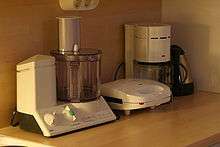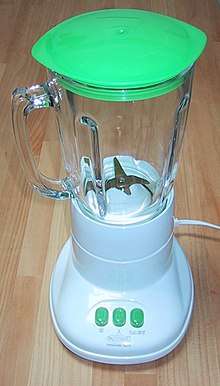Small appliance
A small appliance, small domestic appliance, or small electrics[1] are portable or semi-portable machines, generally used on table-tops, counter-tops, or other platforms, to accomplish a household task. Examples include microwave ovens, toasters, humidifiers, food processors and coffeemakers. They contrast with major appliances (British "white goods"), such as the refrigerator and washing machine, which cannot be easily moved and are generally placed on the floor. Small appliances also contrast with consumer electronics (British "brown goods") which are for leisure and entertainment rather than purely practical tasks.[2]

Uses
Some small appliances perform the same or similar function as their larger counterparts. For example, a toaster oven is a small appliance that performs a similar function as an oven. Small appliances often have a home version and a commercial version, for example waffle irons, food processors, and blenders are small household appliances. A food processor will perform the tasks of chopper, slicer, mixer as well as juicer. Instead of buying multiple small appliances you can buy a single food processor. The commercial, or industrial, version is designed to be used nearly continuously in a restaurant or other similar setting. Commercial appliances are typically connected to a more powerful electrical outlet, are larger and stronger, have more user-serviceable parts, and cost significantly more. These commercial versions are capable of performing heavy tasks in one go.
Types and examples

- Cooking, such as on a hot plate or with a microwave oven
- Heating, such as an electric heater
- Cooling, such as air conditioning or a fan
- Lighting, using light fixtures
- Beverage-making, such as electric kettles, coffeemakers or iced tea-makers
- Some combination of the above processes such as mixing, heating such as in a bread machine
Prices
Small appliances can be very inexpensive, such as an electric can opener, hot pot, toaster, or coffee maker which may cost only a few U.S. dollars, or very expensive, such as an elaborate espresso maker, which may cost several thousand U.S. dollars. Most homes in developed economies contain several cheaper home appliances, with perhaps a few more expensive appliances, such as a high-end microwave oven or mixer. A small appliances like chopper, juicer, grinder and mixer may cost you few dollars. Instead of buying separate units the food processor will be less expensive. Sometime these kind of smart appliances saves money as well as the space.
Powering
Many small appliances are powered by electricity. The appliance may use a permanently attached cord which is plugged into a wall outlet or a detachable cord. The appliance may have a cord storage feature. A few hand-held appliances use batteries, which may be disposable or rechargeable. Some appliances consist of an electrical motor upon which is mounted various attachments so as to constitute several individual appliances, such as a blender, a food processor, or a juicer. Many stand mixers, while functioning primarily as a mixer, have attachments which can perform additional functions.
A few gasoline and gas-powered appliances exist for use in situations where electricity is not expected to be available, but these are typically larger and not as portable as most small appliances. Items that perform the same function as small appliances but are hand powered are generally referred to as tools or gadgets, for example a hand cranked egg beater, a grater, a mandoline, or a hand-powered meat grinder.
Safety
Small appliances which are defective or improperly used or maintained may cause house fires and other property damage, or may harbor bacteria if not properly cleaned. It is important that users read the instructions carefully and that appliances that use a grounded cord be attached to a grounded outlet. Because of the risk of fire, some appliances have a short detachable cord that is connected to the appliance magnetically. If the appliance is moved further than the cord length from the wall, the cord will detach from the appliance.
Definitions and regulations
Designations and regulations of "small appliances" vary by country and are not simply determined by physical sizes. For instance, United States Environmental Protection Agency regulations mandate that small appliances must meet two standards:[3]
- Completely manufactured, charged, and sealed in a factory
- Contains five pounds or less of refrigerant
See also
- Appliance (disambiguation)
- Domestic technology
- Electronics
- List of cooking appliances
- List of home appliances
- Major appliance
- Standby power
- White goods
- Yellow goods (retail classification)
References
- Small Electrics | Big Lots
- Baumann, Ted (1995). An industrial strategy for the household electrical durables industry. UCT Press. p. vi. ISBN 9780799215786.
- Paluca, Kleia. "Understanding Small Appliance Standards and Regulations". Appliance Authority. Retrieved 16 November 2015.